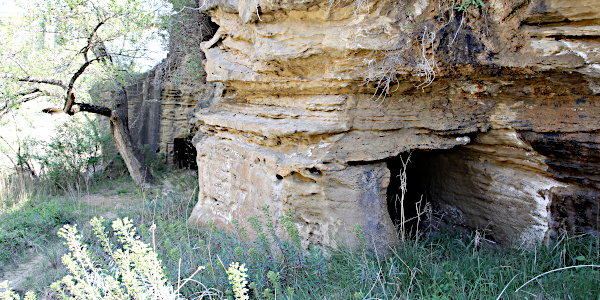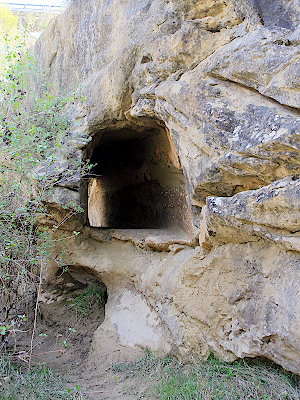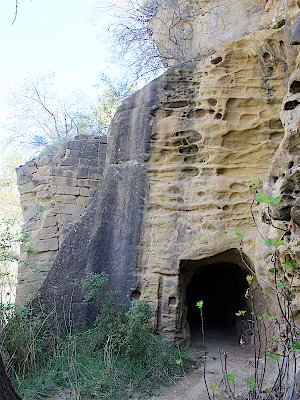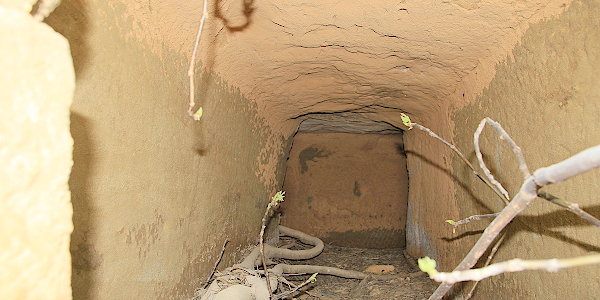Mills in Altoaragón - harinero, central eléctrica
Lascellas
Lascellas is about half way between Barbastro and the city of Huesca.
From Barbastro take the A-22 (Autovía Huesca – Lleida) or the N-240 towards Huesca.
Leave the autovía via exit 77 and follow the signs for
Angüés.
If you took the N-240 continue past Lascellas and after about 2 km you will arrive at the same roundabout.
From there the road descends in a wide bend into the canyon of the
río Alcanadre.
You'll pass a branch to the right, and going to a resting place. Further on the road turns to the right and in this bend a
gravel road leaves to the left. Follow this road down into the canyon and park your vehicle next to the river. If you prefer, there is also
room at the top, next to the tree.
Pictures: 16.iv.2014
There is not much that remains of the mill, which was known as the
Molino de Guiral, after the name of its owner for many years,
José Guiral.
We could only discover a few short pieces of wall that may have been part of the construction (1, 2).
The main point of interest however are the waterworks.
The canal, which carried the water from the dam down to the mill, is carved out of the rock.
The section in the narrowest stretch of the canyon is an alternation of open and covered parts (3 – 5).
The roof of the tunnel is high enough for an average person to stand upright.
Several openings in the wall (6, 7) allow a check of the situation inside.
It is difficult to reach a clear understanding as there seem to be two different systems of tunnels (
†).
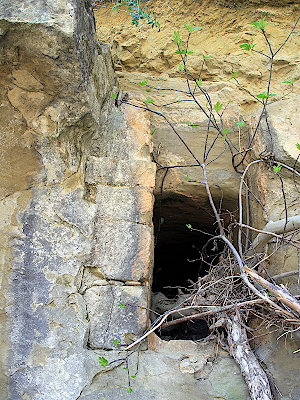
(6)
The mill was owned by a businessman from
Lascellas,
José Guiral. He was a farmer who in addition to running his mill, also
operated as a liquor distiller (
‡).
Before the installation of the power station, the mill produced flour.
It is only from the early 20th century that electricity was generated.
The entry for Lascellas in the Anuario del Comercio of 1908 (¥)
lists a flour mill and a power station, both owned by Guiral. Previous yearbooks only mention the flour mill (§).
The line was soon extended to some neighbouring villages.
In August of 1909 Guiral requests from the ministry the concession to provide electricity in Ponzano, Laluenga, and
Laperdiguera (¶). He goes fast, because the same newspaper a month later (Þ)
announces that Guiral already has done the preparatory work for public lighting and also what is necessary to link
the interested households.
Old maps of the Instituto Geográfico Nacional (MTN50, sheets 287, 325) show
one single line from the mill over Lascellas, to Ponzano, Laluenga, and Laperdiguera: a distance of more than 12 km
without branches.
† Antonio Naval Mas
— 1996 — Construcciones para la historia del Somontano en el Alto Aragón.
Cremallo Edición - Huesca. ISBN: 84-87131-01-8. pp 260 – 264.
‡ Joaquín Coll Clavero
— 2014 — En torno a la relojería de Lascellas (1870–1978)
Centro de Estudios del Somontano de Barbastro: 231pp. ISBN: 978-84-8127-259-8.
¥ Bailly-Bailliere
— 1908 — Anuario del Comercio de la Industria de la Magistratura y de la Administracion de España.
Entry for Lascellas: Alumbrado publico por electricidad
Electricidad (Fábrica de). -- Guiral (José Maria).
Harinas (Molino de). -- Guiral (José).
§ Bailly-Bailliere
— 1900 — op. cit.
Entry for Lascellas: Harinas (Molino de). -- Giral (José).
Notice that in this yearbook and in all earlier ones, Giral is written without the letter 'u'.
¶ El Diario de Huesca
— 06.viii.1909 - p2: D. José Guiral Blecua, vecino de
Lascellas, ha solicitado del ministro de Fomento la concesión de una instalación
eléctrica en los términos municipales de Ponzano, Laluenga y Laperdiguera, con el fin de dar
luz á estos dos últimos pueblos y fuerza matriz á un molino.
Þ El Diario de Huesca
— 07.ix.1909 - p2:
El empresario de la luz eléctrica, señor Guiral, de Lascellas, ha hecho ya las instalaciones oportunas en las casas que la han solicitado, y colocado también las palomillas necesarias para el tendido de la red de la luz de las calles, deduciéndose de ésto que no tardará mucho en que este vecindario disfrutará de tan ventajoso adelanto.






